Accept all cookies Accept only essential cookies See our Cookie Notice

About ESA
The European Space Agency (ESA) is Europe’s gateway to space. Its mission is to shape the development of Europe’s space capability and ensure that investment in space continues to deliver benefits to the citizens of Europe and the world.
Highlights
ESA - United space in Europe
This is ESA ESA facts Member States & Cooperating States Funding Director General Top management For Member State Delegations European vision European Space Policy ESA & EU Space Councils Responsibility & Sustainability Annual Report Calendar of meetings Corporate newsEstablishments & sites
ESA Headquarters ESA ESTEC ESA ESOC ESA ESRIN ESA EAC ESA ESAC Europe's Spaceport ESA ESEC ESA ECSAT Brussels Office Washington OfficeWorking with ESA
Business with ESA ESA Commercialisation Gateway Law at ESA Careers Cyber resilience at ESA IT at ESA Newsroom Partnerships Merchandising Licence Education Open Space Innovation Platform Integrity and Reporting Administrative Tribunal Health and SafetyMore about ESA
History ESA Historical Archives Exhibitions Publications Art & Culture ESA Merchandise Kids Diversity ESA Brand Centre ESA ChampionsLatest
Space in Member States
Find out more about space activities in our 23 Member States, and understand how ESA works together with their national agencies, institutions and organisations.
Science & Exploration
Exploring our Solar System and unlocking the secrets of the Universe
Go to topicAstronauts
Missions
Juice Euclid Webb Solar Orbiter BepiColombo Gaia ExoMars Cheops Exoplanet missions More missionsActivities
International Space Station Orion service module Gateway Concordia Caves & Pangaea BenefitsLatest
Space Safety
Protecting life and infrastructure on Earth and in orbit
Go to topicAsteroids
Asteroids and Planetary Defence Asteroid danger explained Flyeye telescope: asteroid detection Hera mission: asteroid deflection Near-Earth Object Coordination CentreSpace junk
About space debris Space debris by the numbers Space Environment Report In space refuelling, refurbishing and removingSafety from space
Clean Space ecodesign Zero Debris Technologies Space for Earth Supporting Sustainable DevelopmentLatest
Applications
Using space to benefit citizens and meet future challenges on Earth
Go to topicObserving the Earth
Observing the Earth Future EO Copernicus Meteorology Space for our climate Satellite missionsCommercialisation
ESA Commercialisation Gateway Open Space Innovation Platform Business Incubation ESA Space SolutionsLatest
Enabling & Support
Making space accessible and developing the technologies for the future
Go to topicBuilding missions
Space Engineering and Technology Test centre Laboratories Concurrent Design Facility Preparing for the future Shaping the Future Discovery and Preparation Advanced Concepts TeamSpace transportation
Space Transportation Ariane Vega Space Rider Future space transportation Boost! Europe's Spaceport Launches from Europe's Spaceport from 2012
The Argo’s hidden cargo
Thank you for liking
You have already liked this page, you can only like it once!
The constellation of the great ship Argo Navis used to bob along the watery southern horizon of the Mediterranean during times of antiquity.
Said to represent the ship used by Jason and the Argonauts in the quest for the Golden Fleece, it was included by Greek astronomer Ptolemy in his 2nd century AD list of the constellations.
French star-mapper Nicolas Louis de Lacaille split the giant constellation into three pieces in 1752 and this image shows Carina, the keel of the ship. Taken by Japan’s Akari space observatory, it shows a hidden cargo: star-forming dust.
This dust is part of the interstellar medium, which also contains gas. The bright knots reveal dense cores, just a few tenths of a light-year across. These dusty cocoons are where gravity is incubating new stars. They are invisible at optical wavelengths because the dust blocks the light from escaping.
However, the dust’s low temperature means it gives off far-infrared radiation, making it visible to the special detectors on Akari.
This false-colour image, spanning 20x15°, is constructed from three far-infrared bands: blue represents 65 micrometres, green shows 90 micrometres and red codes the 140 micrometre wavelength. The image is part of Akari’s recently released all-sky survey.
This is the first far-infrared all-sky survey since the Infrared Astronomical Satellite (IRAS) was launched by the US, the UK and the Netherlands in 1983. IRAS’s final release of image data was made in 1993 and astronomers have been using it ever since.
Akari’s all-sky survey is both higher resolution and contains longer wavelengths than the IRAS survey.
Akari observed more than 99% of the sky over a period of 16 months. The all-sky images have a resolution of 1–1.5 arcminutes (0.017–0.025º), in four wavelengths: 65, 90, 140 and 160 micrometres.
Akari was the second space mission for infrared astronomy from the Institute of Space and Astronautical Science of the JAXA Japan Aerospace Exploration Agency, this time with ESA’s participation.
-
CREDIT
JAXA -
LICENCE
ESA Standard Licence
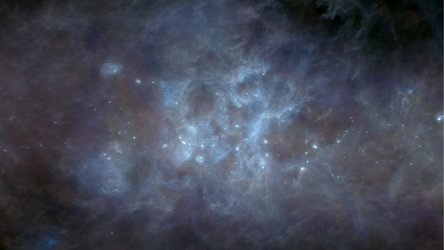
Akari view of the Cygnus region in the Milky Way
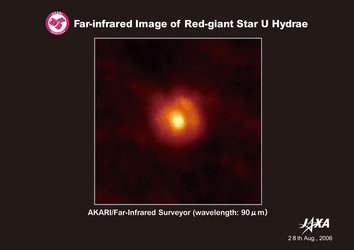
AKARI’s far-infrared image of red-giant star U Hydrae
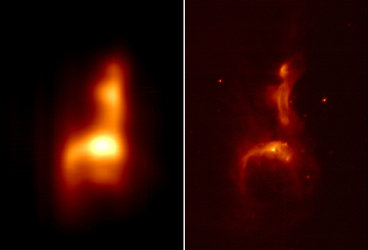
AKARI images of reflection nebula IC4954
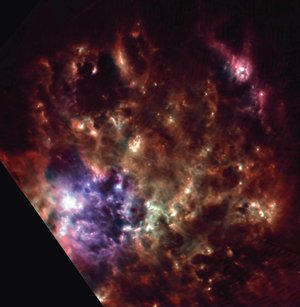
AKARI's Far-infrared view of the Large Magellanic Cloud
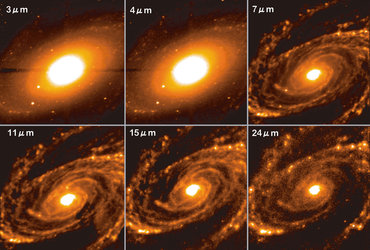














 Germany
Germany
 Austria
Austria
 Belgium
Belgium
 Denmark
Denmark
 Spain
Spain
 Estonia
Estonia
 Finland
Finland
 France
France
 Greece
Greece
 Hungary
Hungary
 Ireland
Ireland
 Italy
Italy
 Luxembourg
Luxembourg
 Norway
Norway
 The Netherlands
The Netherlands
 Poland
Poland
 Portugal
Portugal
 Czechia
Czechia
 Romania
Romania
 United Kingdom
United Kingdom
 Slovenia
Slovenia
 Sweden
Sweden
 Switzerland
Switzerland
























